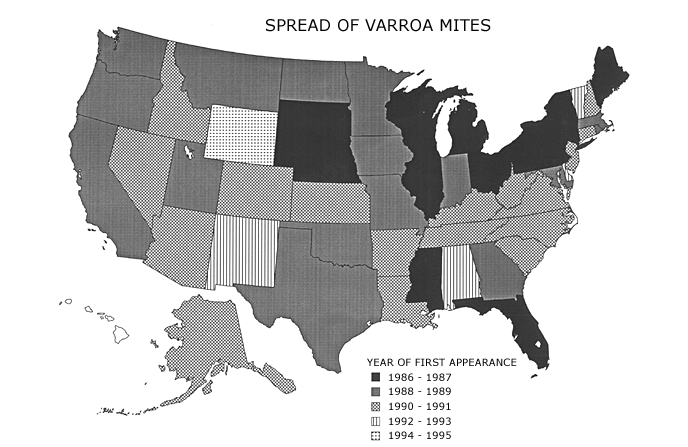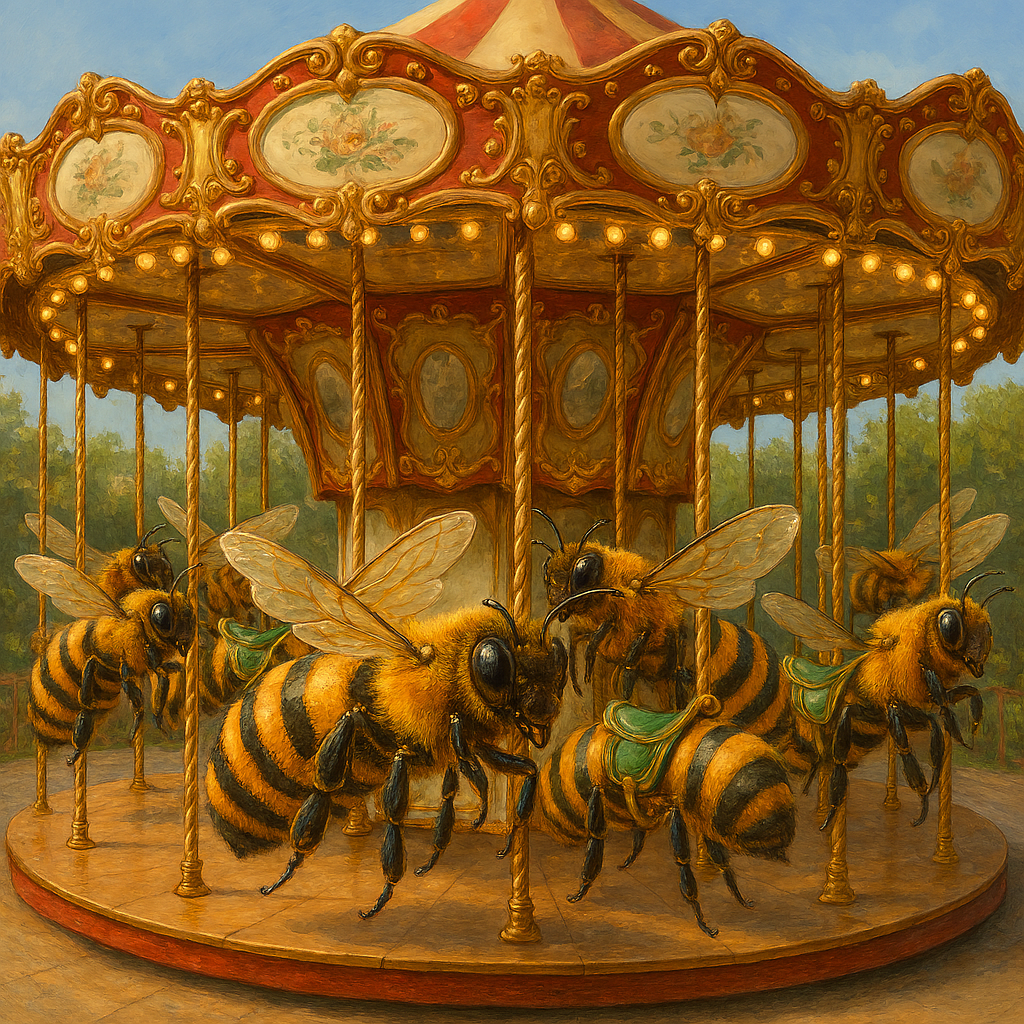Getting Off the Varroa Merry-Go-Round
- Posted
Varroa is Likely Here to Stay
After 38 years (1987-2025), the Varroa destructor is still present in likely every managed colony in the United States. Despite the quarantine and restrictions in place in 1987, a commercial operation in Florida or Wisconsin imported bees for the possible reason of “improving their strain” but unfortunately, they also harbored the Varroa jacobsoni mite. By the fall of that year colonies in hives transported from Florida to Wisconsin began experiencing colony failure. This was the first recorded case of Varroa infestation in this country. Varroa now populates colonies in all contiguous states and Alaska.

Years of first documented incidence in domestic colonies by state in the United States.
Varro mite infestations were first noticed in Wisconsin and Florida, but within a month or two, inspections revealed mite presence in 10 other states possibly caused initially through the sale and transportation of infested colonies from the south to operations in the north and/or pollination services.
This year (2025) significant commercial colony losses of 62% on average were reported between June 2024 and March 2025 partially attributed to viruses vectored by the Varroa destructor along with the possible increasing mite resistance of some of the popular go-to treatments. Hobbyists reported average losses of 51%, Sideliners 54% and Commercial operations 62%. What is extremely concerning is that commercial losses seem to be increasing year after year. In 2023-24, commercial beekeepers reported losses of 55.7% of their managed colonies, which was 16.8 percentage points higher than their previous 13-year average of 38.9%.
Around 1.6 million colonies were lost this year (2025) with associated economic impacts on operations estimated at over $600 million in lost honey production, pollination income, and costs to replace colonies. As the primary managed pollinator, the honey bee, is an integral component of agriculture, providing key pollination services for a wide variety of crops and over one-third of U.S. produce. The value of crops that require bee pollination is estimated to be more than $20 billion annually in the U.S. and $387 billion globally.
Natural Adaptation
What we’re learning from experience is that Varroa is likely here to stay. With the number of managed hives increasing globally, and hive densities in many locations inflated well beyond the natural levels, parasite spread may be impossible to control, however parasite density and population growth can be balanced to permit the growth of healthy colonies. It is simply a matter of adaptation, and examples of this occur all the time in the natural world. The incredible thing is nature’s ability to shift back to a state of equilibrium after a large disturbance. This is exactly what honey bees have done. Several populations of honey bees are reported to be living successfully with Varroa with little to no human-mediated control. Some of these populations currently are used for honey production and are even derived from managed stock in possession of surviving traits.
So, what are these “surviving traits” and how do they work together to provide resistance to Varroa? On this subject the following has been identified: (1) Suppressed Mite Reproduction. Nearly all bees with a natural Varroa resistance have a trait that reduces the reproductive success of the parasite. This collection of traits is sometimes described as “Suppressed Mite Reproduction” or SMR. An example could be Varroa sensitive hygiene (VSH) where infested brood cells are removed and the cycle of mite reproduction is stopped. Another could be the changes in brood pheromonal signals which mites rely on almost exclusively to begin their egg-laying cycles. Also, a more rapid development of the young bees, i.e. a reduced post-capping period could also be a SMR trait. (2) Cell Recapping. Of the resistant populations of Western honey bee, most tested populations have displayed high levels of another trait called “cell recapping”. Cell uncapping is a behavioral trait that is very natural in all honey bee colonies to assess the health of pupating brood; it is the first step to removing diseased or dead brood. Generally, bees do not leave their healthy pupating brood cells open and so they “recap” them. Varroa offspring rely on consistent temperature and humidity inside the cells where they are developing. Disturbances in these constants may be sufficient to reduce the number of offspring that hatch and survive into adulthood. Cell uncapping and recapping can occur multiple times on the same cell, and hypothetically this could result in consistently lower reproductive rates in Varroa foundresses colony wide. There is striking evidence that cell recapping is both increased in surviving colonies and targeted on Varroa-infested brood cells.
The direct link between SMR and cell-recapping has not yet been defined, but their paired presence in surviving populations is quite clear.
Natures System: Genetic Diversity and Selection Pressure
In nature, there are two things that push changes in a species or population: trait variation and pressure from the environment that favors some traits over others. (1) Genetic Diversity. This provides variation in traits, and honey bee biology is designed to maximize genetic diversity: queens naturally mate with multiple drones, and their genetic recombination rates (how the genes from both parents are mixed to produce offspring) are the highest of any animal on earth. Inbreeding depression or low genetic diversity in a hive or population can be due to breeding related individuals resulting in detrimental mutations. Keeping genetic diversity high by having a large number of breeding individuals in your population aligns with the natural strategies of the bees, and though it may make beneficial traits more variable, it will ultimately make healthier bees. (2) Selection Pressure. In nature, individuals that do not possess the traits that give them an edge generally do less well than individuals that do possess these traits, and probability of death slowly decreases their numbers. The answer here is to monitor your colonies and only breed queens from the colonies that did best from the previous year. This develops apiaries with queens of varying ages helping also with drone populations flying to the free mating congregation areas.
Beekeepers Can Participate but Not Control
One thing for the beekeeper to keep in mind is that bees are unique as livestock. They cannot be fenced in and require interaction with the environment. So, they will invariably interact with other bees. This points out the importance of keeping your colonies healthy as well as having a healthy beekeeping community. It is your community that will be the biggest driving force on your colonies over time. There are three things you can work on as a community: (1) Count Mites. Your understanding of your colony’s mite counts in the spring, summer, and fall and how it changes over time can inform your decision of which colony to breed queens from. It’s also important to associate your numbers with the size of the colony which you can assess by counting how many frames your bees are covering. A large number of mites in a small colony would be worse than the same number in a large colony. (2) Breed Your Own Queens. Locally adapted stock does play a role in the health of the colony. You also have a better idea of the traits your bees have verses those of imported bees or queens. (3) Share. Work within your local community on common goals and share stock in support of identifying and developing local Varroa resistant traits. As said before, bees cannot exist in a closed system; to achieve population-wide changes, we will need the collective efforts of many. Start with a group of beekeepers from your local bee club who are also interested, record your progress, and pass along what you learn.
Referenced Materials
- Detection of amitraz resistance and reduced treatment efficacy in the Varroa Mite, Varroa destructor, within commercial beekeeping operations
- Varro Control Past and Future
- Varroa Mite Spread in the United States
- USDA Researchers Find Viruses from Miticide Resistant Parasitic Mites are Cause of Recent Honey Bee Colony Collapses
- Insights from Norway: Using Natural Adaptation to Breed Varroa-Resistant Honey Bees
- Norwegian honey bees surviving Varroa destructor mite infestations by means of natural selection
- Three Decades of Selecting Honey Bees that Survive Infestations by the Parasitic Mite Varroa destructor: Outcomes, Limitations and Strategy
- (YouTube) What Makes Wild Honey Bees Different From Managed Ones? Dylan Ryals PhD Candidate
- (YouTube) Lessons from Norway: How Beekeepers Select for Varroa Resistance | Dr Melissa Oddie
- Reduced Postcapping Period in Honey Bees Surviving Varroa destructor by Means of Natural Selection
